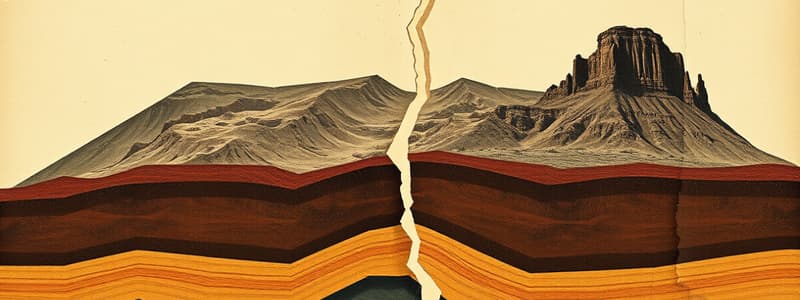Podcast
Questions and Answers
What is the primary process occurring at divergent boundaries?
What is the primary process occurring at divergent boundaries?
- Plates move towards each other causing subduction.
- Plates move apart from each other and form new crust. (correct)
- Plates slide past each other horizontally.
- Plates create mountain ranges by colliding.
Which geological feature is commonly associated with convergent boundaries?
Which geological feature is commonly associated with convergent boundaries?
- Fault lines
- Volcanic islands
- Trenches (correct)
- Mid-ocean ridges
What type of stress occurs at transform boundaries?
What type of stress occurs at transform boundaries?
- Elastic
- Compression
- Tension
- Shear (correct)
Which statement about earthquakes is accurate concerning plate boundaries?
Which statement about earthquakes is accurate concerning plate boundaries?
Which example represents an oceanic-continental convergent boundary?
Which example represents an oceanic-continental convergent boundary?
What is a significant impact of divergent boundaries on ecosystems?
What is a significant impact of divergent boundaries on ecosystems?
In which situation would compression stress be observed?
In which situation would compression stress be observed?
Which of the following describes the formation of crust at plate boundaries?
Which of the following describes the formation of crust at plate boundaries?
Flashcards are hidden until you start studying
Study Notes
Different Processes that Occur Along Plate Boundaries
-
Divergent Boundaries
- Plates move apart from each other.
- Commonly found on ocean floors (mid-ocean ridges).
- Formation of new crust through volcanic activity.
- Example: Mid-Atlantic Ridge.
-
Convergent Boundaries
- Plates move towards each other.
- Can lead to subduction, where one plate is forced below another.
- Causes volcanic activity and mountain building.
- Types:
- Oceanic-continental (oceanic plate subducts).
- Oceanic-oceanic (older oceanic plate subducts).
- Continental-continental (mountain ranges formed).
- Example: Himalayas (continental-continental).
-
Transform Boundaries
- Plates slide past each other horizontally.
- Causes friction and can lead to earthquakes.
- No new crust is formed or destroyed.
- Example: San Andreas Fault.
-
Types of Stress at Plate Boundaries
- Tension: Occurs at divergent boundaries, stretching the crust.
- Compression: Occurs at convergent boundaries, pushing the crust together.
- Shear: Occurs at transform boundaries, sliding past each other.
-
Geological Features Associated with Plate Boundaries
- Mid-ocean ridges: Formed at divergent boundaries.
- Trenches: Formed at convergent boundaries, where subduction occurs.
- Fault lines: Formed at transform boundaries.
-
Earthquakes and Volcanoes
- Most earthquakes occur at plate boundaries due to the movement and stress.
- Volcanic activity is prevalent at divergent and convergent boundaries, especially at subduction zones.
-
Impact on Ecosystems and Human Activity
- Formation of new landforms can create diverse ecosystems.
- Earthquake and volcanic activity can have significant effects on human settlements and infrastructure.
Divergent Boundaries
- Plates separate, leading to new crust formation through volcanic activity.
- Commonly located at mid-ocean ridges, such as the Mid-Atlantic Ridge.
Convergent Boundaries
- Plates collide, resulting in subduction where one is forced under the other.
- Generates volcanic activity and mountain formation.
- Types include:
- Oceanic-continental: Oceanic plate subducts beneath a continental plate.
- Oceanic-oceanic: Older oceanic plate subducts under a younger one.
- Continental-continental: Both plates push against each other, forming mountain ranges like the Himalayas.
Transform Boundaries
- Plates slide past each other, creating friction and causing earthquakes.
- No creation or destruction of crust occurs.
- Notable example: San Andreas Fault.
Types of Stress at Plate Boundaries
- Tension: Occurs at divergent boundaries; stretches the crust.
- Compression: Found at convergent boundaries; pushes crust together.
- Shear: Present at transform boundaries; causes sliding movement.
Geological Features Associated with Plate Boundaries
- Mid-ocean ridges develop at divergent boundaries.
- Trenches form at convergent boundaries where subduction takes place.
- Fault lines arise at transform boundaries due to sliding plates.
Earthquakes and Volcanoes
- Majority of earthquakes originate at plate boundaries, linked to tectonic stress.
- Volcanic activity is significant at divergent and convergent boundaries, particularly at subduction zones.
Impact on Ecosystems and Human Activity
- New landforms from tectonic processes contribute to diverse ecosystems.
- Earthquakes and volcanic activity can severely affect human settlements and infrastructure, posing risks to safety and development.
Studying That Suits You
Use AI to generate personalized quizzes and flashcards to suit your learning preferences.




